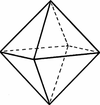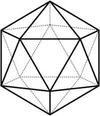Level 1C Flashcards
(51 cards)
Evaluate 132.
169
Evaluate 162
256
Evaluate 192
361
Evaluate 212.
441
Evaluate 242
576.
Evaluate 272
729.
Evaluate 302
900
Evaluate 43
64
Evaluate 63
216
Evaluate 83
512
Evaluate 103
1000
Evaluate 123
1728
Evaluate 143
2744
Evaluate 25
32
Evaluate 28
256
Evaluate 211
2048
Evaluate 214
16384
What are the five platonic solids?
Tetrahedron, Hexahedron (Cube), Octahedron, Dodecahedron, Icosahedron.

Describe the characteristics of a tetrahedron.
A tetrahedron has the following properties:
1) 4 equilateral triangle faces
2) 4 vertices
3) 6 edges

Describe the characteristics of a hexahedron (cube).
A hexahedron has the following characteristics:
1) 6 square faces
2) 8 vertices
3) 12 edges

Describe the characteristics of an octahedron.
An octahedron has the following characteristics:
1) 8 equilateral triangle faces.
2) 12 edges
3) 6 vertices

Describe the characteristics of a dodecahedron.
A dodecahedron has the following characteristics:
1) 12 regular pentagon faces
2) 30 edges
3) 20 vertices

Describe the characteristics of an icosahedron.
An icosahedron has the following characteristics.
1) 20 equilateral faces
2) 30 edges
3) 12 vertices

What are the prime numbers from 100 to 120?
101, 103, 107, 109, 113


